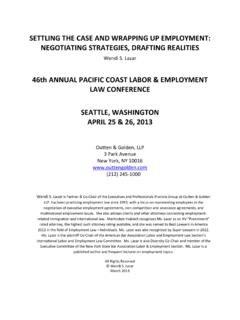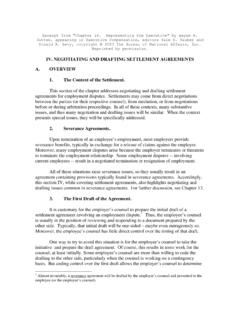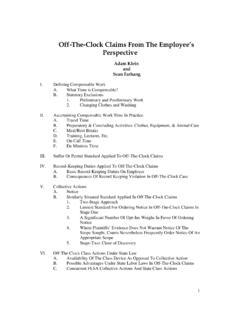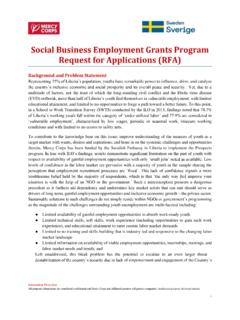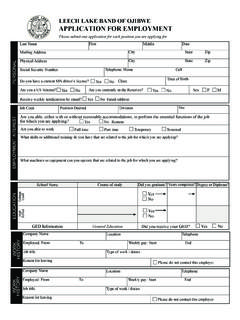Transcription of Can Law Firm Partners Sue the Firm for Employment ...
1 This article originally appeared in Law Journal Newsletters' Law Firm Partnership & Benefits Report, Februrary 2004. For more information, visit CAN LAW FIRM Partners SUE THE FIRM FOR Employment DISCRIMINATION? Wayne N. Outten Justin M. Swartz Outten & Golden, LLP13 Park Avenue, 29th Floor New York, NY 10023 (212) 245-1000 Fax: (212) 977-4005 I. OVERVIEW Traditionally, law firms were organized as true partnerships in which each partner had a substantial voice in firm affairs and could be subjected to unlimited liability for the debts of the firm. As high profile cases have highlighted the risks of such a structure, however, many firms have abandoned the classic form and adopted hybrid business models such as professional corporations, limited liability companies, and limited liability partnerships. In these hybrid business models, firms often choose to consolidate management and control of the firms affairs in small executive or management committees.
2 Firms also, with increased frequency, have created tiered partnerships and quasi-partner positions for senior attorneys such as of counsel, special counsel, junior partner, or non-equity partner. By creating these less-than-full-partnership-positions, firms can ensure that the management of the firm remains in the hands of a few Partners in the inner circle while retaining experienced, senior attorneys who can generate substantial revenue for the firm. Such consolidation of control, comes at a cost, however. By configuring themselves as de facto corporations, placing substantial control in the hands of a few, and subjecting the remaining Partners to the decisions of those in power, firms may expose themselves to Employment discrimination suits brought by their own Partners . 1 Outten & Golden, LLP represents employees, executives, and Partners in all areas of Employment law.
3 Wayne N. Outten, the managing partner of Outten & Golden, concentrates on counseling and representing executives, employees, and Partners regarding contracts, disputes, and lawsuits. He writes and lectures extensively on employee rights and Employment law. Justin M. Swartz, an associate at Outten & Golden, represents employees in individual and class discrimination and wage and hour cases. The federal Employment discrimination laws the Civil Rights Act of 1964 ( Title VII ), the Age Discrimination in Employment Act ( ADEA ), and the Americans with Disabilities Act ( ADA ) protect employees of companies, not employers or owners. Law firm associates are undoubtedly employees and can therefore invoke the Employment discrimination laws. Hishon v. King and Spaulding, 467 69 (1984). It is a more complicated question, however, whether those laws protect law firm Partners .
4 Under hornbook partnership law, law firm Partners are co-owners of the firm, not employees, and therefore would seem to be unprotected from Employment discrimination. In Hishon, Justice Powell explained in his concurring opinion that Title VII does not protect Partners in law firms because a partner s relationship to the firm differs markedly from that between employer and employee. A law partnership involves the common conduct of a shared enterprise. The relationship among law Partners contemplates that decisions will be made by common agreement or consent among the Partners . Hishon, 467 at 79-80. Many of today s law firms, however, bear little resemblance to the firm that Justice Powell describes. As a partner s relationship with the firm strays further from Justice Powell s notion of a shared enterprise, and closer to a master / servant relationship, courts are more likely to deem a partner an employee for purposes of Employment discrimination laws.
5 Indeed, the caselaw is clear that Partners are not always employers. See , v. Sidley Austin Brown & Wood, 315 696, 702 (7th Cir. 2002). A law firm cannot avoid liability under Employment discrimination laws simply by labeling attorneys as Partners . Hishon, 467 at 80, (Powell, J. concurring); Sidley, 315 at 702. For years courts have struggled to determine when Partners are employees and therefore protected by the Employment discrimination statutes. The recent popularity of the various hybrid business models has only added to the confusion. The Supreme Court provided some much needed guidance in its recent decision in Clackamas Gastroenterology Assoc, v. Wells, 123 1673 (2003). The Court endorsed a six factor test and held that the principal guidepost in the determination must be the amount of control that the firm has over the partner in question and the degree to which the partner can influence the management of the firm.
6 Id. at 1679. Importantly, the Court s approach makes no distinction among the various business models. This article will first discuss reasons that law firms, especially large firms, are susceptible to discrimination suits by their Partners . Next, it will explain two threshold requirements for law firm Partners to sue their firms for Employment discrimination. Both of these requirements turn on whether certain Partners are deemed employees. Third, the article will discuss the Supreme Court s Clackamas decision and lower court decisions that preceded Clackamas but used similar analyses. Finally, it will note that, under some federal and state laws, law firms are vulnerable even if their Partners are not deemed employees. II. LAW FIRMS ARE PARTICULARLY vulnerable TO Employment DISCRIMINATION SUITS Many law firms are highly segregated by gender and race.
7 JENNIFER L. PIERCE, GENDER TRIALS 1 (University of California Press 1995). For example, in the New York City offices of the 20 most prestigious New York law firms (according to The Vault Guide to the Top 100 Law Firms, 6th Edition, 2003), only 14% of all Partners are women while women constitute of all associates. The numbers for minorities are even worse: of Partners and of associates in these offices are minorities. Only of Partners and of associates are African-Americans. (These statistics were aggregated by the authors of this article using data from the National Association for Law Placement Law Firm Questionnaires, 2003-2004 academic year.) It is likely that the disparities at many smaller, regional firms are even more pronounced. See Women and Attorneys of Color 2002 Summary Chart, National Association for Law Placement, 2002, available at ; and Equal Employment Opportunity Commission Press Release, October 22, 2003, available at Moreover, these statistics do not distinguish between tiers or classes of Partners ( , equity / non-equity, voting / non-voting, or senior / junior).
8 The presence of tiers or classes of Partners likely perpetuates the disparities and may even amplify them. Anecdotal evidence indicates that women and minorities constitute a miniscule percentage of the highest-tier Partners at large firms. Although statistical disparities like those cited above do not, without more, violate federal anti-discrimination laws, such disparities expose firms to attack. First, statistical disparities can be used to prove discriminatory intent. EEOC v. O&G Spring and Wire Forms Specialty Company, 38 872, 877 (7th Cir. 1994). Statistics can also form the foundation for glass ceiling suits and suits alleging that a firm has engaged in a pattern or practice of discrimination, Int l Brotherhood of Teamsters v. United States, 431 324, 336 (1977); Hazelwood School Dist. V. United States, 433 299, 308 (1977); Robinson v.
9 Metro-North Commuter Co., 267 147, 158 (2d Cir. 2001) ( Statistics alone can make out a prima facie case of discrimination .. ). Further, disparate impact suits, alleging that certain Employment practices or policies have a significantly greater impact on women or minorities than on others, are most often proved through statistical evidence. Robinson, 267 at 160. Moreover, minority and female employees who are notably under-represented in the upper ranks of a firm are more likely to believe that their gender or race is a factor when the firm takes adverse Employment actions against them. Reputable social science research indicates that they may be right; in white-male-dominated, highly segregated environments, gender and race stereotypes can influence subjective Employment decisions. See, , Butler v. Home Depot, Inc., 1997 WL 605754 at *7-11 ( Cal.)
10 Aug. 29, 1997) (denying summary judgment based, in part, on such social-science testimony). It is at least arguable, if not likely, that many large law firms have such environments. Employment decisions in law-firms are particularly susceptible to the influence of stereotypes because they are often, by nature, largely subjective. Hiring decisions, promotion decisions, case-staffing decisions, and compensation decisions are all often based, at least in part, on non-quantifiable criteria. See CYNTHIA FUCHS EPSTEIN, WOMEN IN LAW 200-03 (University of Illinois Press 1993). These types of decisions are particularly vulnerable to the influence of unlawful gender or race stereotypes. Butler, 1997 WL 605754, at *7; see Price Waterhouse v. Hopkins, 490 228, 251 (1989) ( we are beyond the day when an employer could evaluate employees by assuming or insisting that they matched the stereotype associated with their group ).
